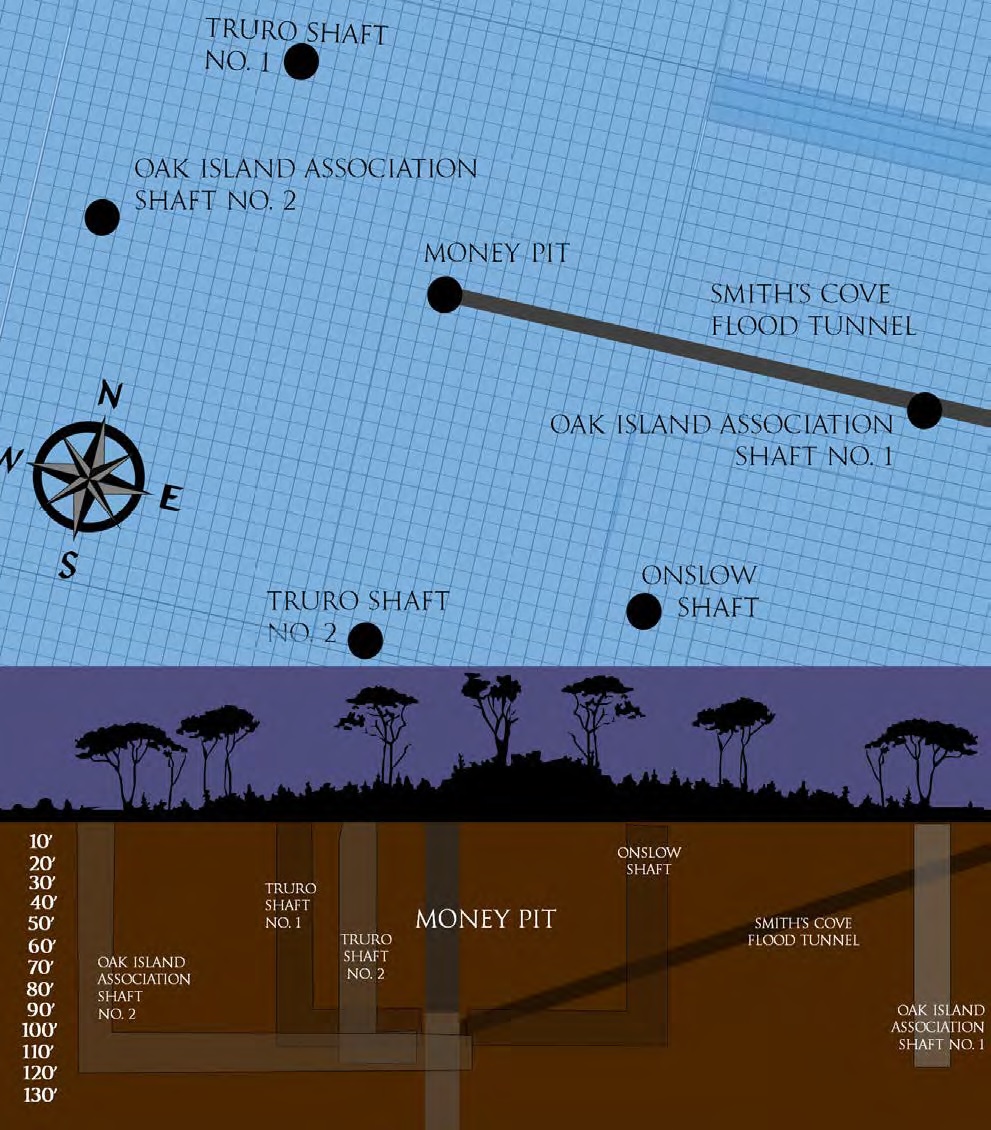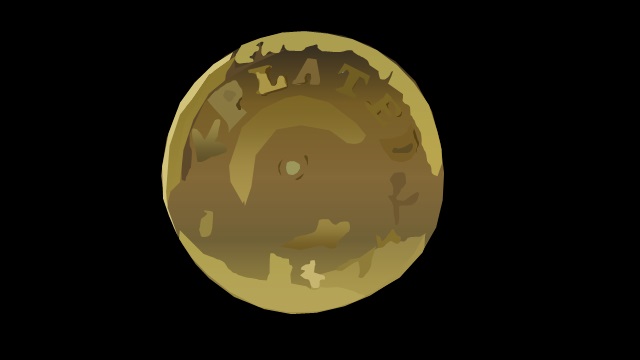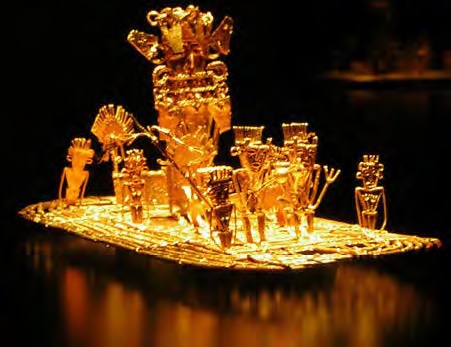Wow! What a way to end the season! Read on for a Plot Summary of the Season 4 Finale of the History Channel’s TV series The Curse of Oak Island. Although I could have included an Analysis at the end of this article as I usually do, speculating as to the nature of the mysterious discoveries made in this episode, I imagine many of our questions will be answered in The Curse of Oak Island: Drilling Down episode scheduled to air next week. See you then!
Plot Summary
The episode begins at the Money Pit, where the men of Oak Island Tours Inc. are sinking a fourth shaft, dubbed GAL1 (George and Anne Lagina #1) in honour of Rick and Marty’s late parents. Craig Tester, upon observing the hand-hewn wooden timbers being extracted from the shaft, expresses his belief to Rick Lagina that they might have intersected a searcher tunnel constructed in 1861 by the Oak Island Association, which connected the ‘Oak Island Association Shaft #2’ with the Money Pit, located 18 feet to the east.

Meanwhile, on Oak Island’s Lot 18, Marty Lagina, Charles Barkhouse, and metal detection expert Gary Drayton sift through the debris brought up from GAL1 with a metal detector. In time, Drayton discovers what he believes to be an iron sailing cloth needle, used for sewing canvas sails. Shortly thereafter, he discovers a gold-plated military officer’s button. The narrator reminds us that this find is congruent with Oak Island Tours Inc.’s discoveries in Season 4, Episode 8, which included a dandy button, a lead ingot used for making musket balls, an identificatory plate from a musket, and six copper coins bearing the image of King George II of Great Britain- items suggesting that Oak Island’s subterranean anomalies are the work of 18th Century British military men.

Later that day, the Oak Island crew is visited by sisters Jean and Joan McGinnis, descendants of Daniel McGinnis, one of the three co-discoverers of the Money Pit. This is not the McGinnis sisters’ first Oak Island adventure; in Season 3, Episode 13, Jean and Joan, along with their late sister Joyce, paid a visit to the island, where they presented the Oak Island team with a small gold cross allegedly discovered by Daniel McGinnis in the Money Pit more than 200 years ago.

Jean and Joan have come to Oak Island to honour the memory of their late sister Joyce. Rick Lagina, Dave Blankenship, and Jack Begley accompany the sisters to the foundations of the old McGinnis home on the western end of Oak Island. There, beneath one of the foundations stones, they inter a bauble of colourful blown glass crafted from Joyce’s ashes.
Later, the party heads to the Oak Island Visitor’s Centre, where art and antiquities expert Dr. Lori Verderame examines the McGinnis sisters’ gold cross. After careful scrutiny, Dr. Verderame concludes that the cross is composed of high quality (22-24 carat) rose gold, and was likely cast in the Spanish West Indies sometime between 1550 and 1700. She also states that the purpose of the cross’s many holes was to house emeralds. The narrator follows up on this revelation by summarizing the theory that Oak Island’s underground workings are attributable to the crew of a Spanish treasure galleon, and that the Oak Island treasure consists of silver, gold, precious stones, and other New World riches.

Next, Rick Lagina, Dave Blankenship, and Charles Barkhouse ask Dr. Verderame to appraise additional historical artifacts they have unearthed on Oak Island. Verderame quickly concludes that the identifactory musket plate discovered in Season 4, Episode 8 is inscribed with the name ‘Ball’, indicating that it likely belonged to Samuel Ball, the one-time Oak Island resident and Revolutionary War veteran on whose property the item was discovered. Verderame also examines the railroad spike-like object Gary Drayton discovered in the Oak Island swamp in Season 4, Episode 7, which Drayton claimed to be a nail from the deck of a wooden sailing ship. Dr. Verderame claims that she will need to examine this object more closely before she can accurately speculate as to its nature.
The following day, Marty Lagina and Craig Tester meet with contractor Andrew Folkins of Irving Equipment Ltd. at the Money Pit site. Folkins informs the two treasure hunters that Borehole GAL1 has been excavated to a depth of 151 feet, and that it has, thus far, encountered nothing of interest aside from a handful of wood fragments.
On Oak Island’s Lot 18, Dave Blankenship, Jack Begley, and Gary Drayton examine more of the spoils from GAL1. After searching for some time, they discover a piece of hammered metal sheet bearing a small square hole.

Back at the Money Pit area, Marty Lagina and Craig Tester watch as the men of Irving Equipment Ltd. bring up load after load from Borehole GAL1. As Rick Lagina joins the men, the hammergrab being used to excavate the shaft emerges from the caisson with large wooden timbers in its jaws. A subsequent hammergrab scoop reveals more of the same. However, the timbers from this second scoop appear to be coated in a viscous black substance which Marty suggests is resin or pine tar.
Shortly after Dave Blankenship joins the crew, the hammergrab emerges from the caisson with a sizable sheet of hammered metal. Every crew member present is dumbfounded by this strange new discovery. Craig Tester suggests that perhaps the metal- which was brought up from a depth of 154 feet- is a remnant of a protective cover used in conjunction with the Onslow or Truro Company’s cast iron steam-powered pumps. Veteran treasure hunter Dave Blankenship states that the metal scrap”has no business being down there that I know of.”

The next load from GAL1 contains similar metal scraps. It also contains a piece of charcoal, one of the items allegedly discovered in the original Money Pit by the Onslow Company in 1804, along with coconut fibre, clay putty, and beach stones. The narrator reminds us that, over the years, some Oak Island researchers have postulated that the charcoal discovered in the Money Pit are relics of a subterranean furnace which the original excavators used to draw fresh air into the shaft.

Upon hearing of the new discoveries, Marty Lagina joins the crew. He examines the metal scraps, and theorizes that they might comprise the impenetrable iron object encountered at a depth of 171 feet (161 feet today, as a result of Robert Dunfield’s heavy duty operations in the late 1960’s) by the Oak Island Treasure Company in 1897.

As members of Oak Island Tours Inc. speculate as to the nature of the mysterious metal sheets, Andrew Folkins informs them that the GAL1 caisson has encountered an impenetrable substance and is no longer advancing into the earth. After some deliberation, the crew agrees that they ought to attempt to break up the impenetrable substance with a 4-ton chisel bit, and then excavate the broken rubble with the hammergrab.
While the crew waits for Irving Equipment Ltd. to perform the chisel bit operation, Rick Lagina, Jack Begley, Charles Barkhouse, and Dan Blankenship meet with Dr. Lori Verderame at Blankenship’s Oak Island residence. There, Dr. Verderame informs the men the spike discovered by Gary Drayton in the Oak Island swamp is, as Drayton predicted, a wrought iron barrote nail of the type commonly used in the construction of Spanish galleon decks. She dates the artifact to between 1575 and 1600.

Back at the Money Pit, Marty Lagina and Craig Tester watch as the men of Irving Equipment Ltd. prepare to continue excavating GAL1 with a smaller hammergrab. The narrator informs us that the chisel bit operation sufficiently loosened the earth below the 154-foot level to allow it to be excavated with a smaller hammergrab, but that the caisson will still not advance any deeper.
The first load brought up from GAL1 with the smaller hammergrab contains a thick, bent, perforated steel rectangle which Craig Tester believes to be a “corner plate”. This load also contains a large rusted steel washer which is congruent with the corner plate’s perforations. Additional loads from GAL1 contain primitive-looking steel nuts, screws, and other interesting metal objects.

Suddenly, during a retrieval operation, the hammergrab snags on some sort of underground obstacle. After some maneuvering by crane operator Michel Ouellette, the hammergrab breaks free and is winched to the surface. Loathe to damage the hammergrab or further jeopardize the structural integrity of the underground object they seem to have discovered, the Oak Island team decides to wrap up operations in Borehole GAL1.
Three days later, the Oak Island crew congregates at the War Room. There, they contact Dr. Lori Verderame via Skype. Verderame informs the team that the button discovered in GAL1 is, indeed, a gold-plated button which bears the characteristics of British military officer buttons used between 1775 and 1815. She goes on to claim that the bent, perforated steel rectangle brought up from GAL1 is a decorative bracket “used to actually attach the metal or wooden sides of treasure chests”. She maintains that the nature of this artifact- dated from 1650-1800-, along with other pieces of metal brought up from GAL1, seems to imply that the men who buried treasure on Oak Island used recycled ship materials to construct their treasure chest. The team thanks Dr. Verderame for her work and ends the call.
After the call, the men of Oak Island Tours Inc., cognizant of the rapid approach of winter and the end of another season on Oak Island, discuss what they would like to accomplish in the future. Rick proposes that the team conduct a rigorous metallurgical analyses of the metal brought up from GAL1- a proposal to which Marty agrees wholeheartedly. Craig Tester then expresses his desire to further explore the Oak Island swamp- an endeavor which Marty is less keen on pursuing, but which both Rick and Charles support. Jack Begley then maintains that he would like to continue excavations on Smith’s Cove in light of their recent discoveries there.
[purchase_link id=”4583″ style=”” color=”” text=”The Complete Guide to Oak Island”]
Marty Lagina commends the team on their incredible discoveries this season, and asks whether or not they think it is “prudent to continue”. Dan Blankenship advises the team to spend the winter contemplating that question, and recommends that they “take sufficient time to analyze the pros and cons” before making a decision. Marty, Craig, and Rick agree to consider Blankenship’s advice, while Charles and Dan passionately implore their fellow team members to not give up the search. In the end, the team agrees to “adjourn for the season and contemplate what comes next.” With that, the season is ended.
Want to Help?
If you enjoyed this article and would like to help support this website, please check out our online bookstore:







Dr. Lori Verderame
Thank you for your recount of the 2 hour season 4 finale and additional commentary. For your information, the links to Dr. Lori Verderame’s website and her comments on her role in the Oak Island treasure hunt is http://www.DrLoriV.com and http://www.Facebook.com/DoctorLori
Hammerson Peters
Dr. Lori! Thanks for checking us out, and for the links.
Mike Rogers
Hi,
Just wanted to say that you do a great job with this website. I love the more “in depth” analyses you provide along with the additional historical contexts. Thank you! I really do hope the Laginas and the History Channel continues this series. It is by far the most interesting show on TV right now. And if they do, I also hope you continue providing these episode recaps. They are great!!
Take care,
Mike
Hammerson Peters
Thank you so much for the kind words, Mike! There’s nothing more gratifying than knowing that your work is being enjoyed and put to good use. If ‘The Curse of Oak Island’ is renewed next year, we will definitely be doing similar plot summaries and analyses of the episodes.
Marvin Rogers
Since finding the bone in X-10, nothing more has been said. Is it human or animal? How old is it?
Hammerson Peters
Hi Marvin, thanks for the question. I don’t know for sure, and can’t speak with any authority on this, but I assume the bone is a cat bone (if it was human, they almost certainly would have mentioned it in the show). Back in Season 1, they performed a similar flushing operation in 10-X and brought up some small bones. They turned out to be cat bones, belonging to one of Dan Henskee’s kittens that fell into the shaft sometime in the 1970’s.